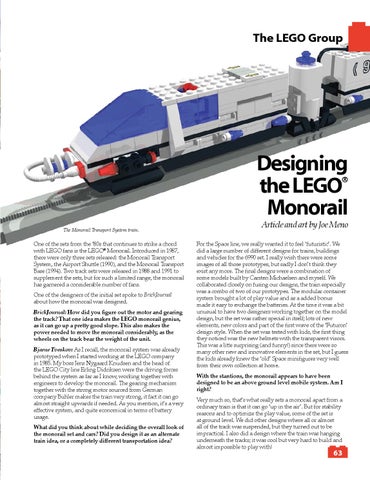The LEGO Group
Designing the LEGO® Monorail The Monorail Transport System train.
One of the sets from the ‘80s that continues to strike a chord with LEGO fans is the LEGO® Monorail. Introduced in 1987, there were only three sets released: the Monorail Transport System, the Airport Shuttle (1990), and the Monorail Transport Base (1994). Two track sets were released in 1988 and 1991 to supplement the sets, but for such a limited range, the monorail has garnered a considerable number of fans. One of the designers of the initial set spoke to BrickJournal about how the monorail was designed. BrickJournal: How did you figure out the motor and gearing the track? That one idea makes the LEGO monorail genius, as it can go up a pretty good slope. This also makes the power needed to move the monorail considerably, as the wheels on the track bear the weight of the unit. Bjarne Tveskov: As I recall, the monorail system was already prototyped when I started working at the LEGO company in 1985. My boss Jens Nygaard Knudsen and the head of the LEGO City line Erling Didriksen were the driving forces behind the system as far as I know, working together with engineers to develop the monorail. The gearing mechanism together with the strong motor sourced from German company Bühler makes the train very strong, it fact it can go almost straight upwards if needed. As you mention, it’s a very effective system, and quite economical in terms of battery usage. What did you think about while deciding the overall look of the monorail set and cars? Did you design it as an alternate train idea, or a completely different transportation idea?
Article and art by Joe Meno
For the Space line, we really wanted it to feel ‘futuristic’. We did a large number of different designs for trains, buildings and vehicles for the 6990 set. I really wish there were some images of all those prototypes, but sadly I don’t think they exist any more. The final designs were a combination of some models built by Carsten Michaelsen and myself. We collaborated closely on fusing our designs, the train especially was a combo of two of our prototypes. The modular container system brought a lot of play value and as a added bonus made it easy to exchange the batteries. At the time it was a bit unusual to have two designers working together on the model design, but the set was rather special in itself; lots of new elements, new colors and part of the first wave of the ‘Futuron’ design style. When the set was tested with kids, the first thing they noticed was the new helmets with the transparent visors. This was a litte surprising (and funny!) since there were so many other new and innovative elements in the set, but I guess the kids already knew the ‘old’ Space minifigures very well from their own collection at home. With the stantions, the monorail appears to have been designed to be an above ground level mobile system. Am I right? Very much so, that’s what really sets a monorail apart from a ordinary train is that it can go ‘up in the air’. But for stability reasons and to optimize the play value, some of the set is at ground level. We did other designs where all or almost all of the track was suspended, but they turned out to be impractical. I also did a design where the train was hanging underneath the tracks; it was cool but very hard to build and almost impossible to play with!
63
